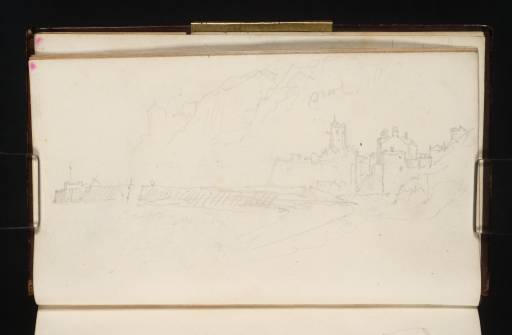Joseph Mallord William Turner Folkestone Harbour from the Beach, with St Mary and St Eanswythe's Church in the Distance 1825
Image 1 of 2
Joseph Mallord William Turner,
Folkestone Harbour from the Beach, with St Mary and St Eanswythe's Church in the Distance
1825
Joseph Mallord William Turner 1775–1851
Folio 10 Verso:
Folkestone Harbour from the Beach, with St Mary and St Eanswythe’s Church in the Distance 1825
D18860
Turner Bequest CCXIV 10a
Turner Bequest CCXIV 10a
Pencil on white wove paper, 95 x 155 mm
Inscribed by Turner in pencil ‘[?Sand]’ towards top right
Inscribed by Turner in pencil ‘[?Sand]’ towards top right
Accepted by the nation as part of the Turner Bequest 1856
References
1909
A.J. Finberg, A Complete Inventory of the Drawings of the Turner Bequest, London 1909, vol.II, p.651, CCXIV 10a, as ‘Do. do.’ (i.e. ditto: ‘Scene on coast. (? at Folkestone.)’).
With the page turned horizontally, the view is west from the beach outside Folkestone harbour, as tentatively suggested by Finberg.1 The eastern pier runs across the centre of the main view, with the narrow harbour entrance to the left, overlooked by St Mary and St Eanswythe’s Church on the cliff in the distance. The harbour was later considerably expanded and redeveloped, and the houses shown do not survive. There is a slight reprise and continuation of the right foreground at the top, with the crumbling cliffs apparently marked ‘Sand’, reflecting their largely sandstone composition; this stretch is now shored up by an arcaded concrete promenade.
The prospect is closely comparable with that of an undated watercolour of Fishing Boats on Folkestone Beach, Kent (National Gallery of Ireland, Dublin).2 It has been linked by Andrew Wilton to the Picturesque Views in England and Wales3 and later by Eric Shanes to the Ports of England4 (both ongoing at the time), and subsequently by Ian Warrell to ‘The English Channel, or La Manche’, an unrealised project publicised early in 1827.5 The watercolour features a strong contre-jour effect towards sunset, with the pier in silhouette, perhaps prompted by the shading in the present sketch.
See also folios 11 recto and verso (D18861–D18862), and Tate D17760–D17761 (Turner Bequest CCIII C, D), respectively a watercolour study and pencil outline from similar angles. Whatever Turner’s original intention, in the event the Dublin composition was not engraved until about 1844, supposedly for an elusive volume of poems by a Dr Broadley, but not published until 1867 in the compendium Art and Song; Tate does not hold an impression, but see under T05183–T05186, the other miscellaneous subjects associated with the project.
This is among numerous sketches showing aspects of the harbour. For Turner’s other Folkestone views in this book and elsewhere, see under the view in the same direction from within the harbour on folio 8 recto (D18855); the entry also discusses the quite different Folkestone subject engraved in 1826 for the Picturesque Views on the Southern Coast, relating to adjacent sketches.
Matthew Imms
September 2020
Andrew Wilton, J.M.W. Turner: His Life and Work, Fribourg 1979, p.403 no.884, as ‘A view of Folkestone, with beached fishing-boat’, ?c.1830, reproduced.
See Eric Shanes, Turner’s Rivers, Harbours and Coasts, London 1981, p.39, and Turner’s England 1810–38, London 1990, p.146, as c.1828.
How to cite
Matthew Imms, ‘Folkestone Harbour from the Beach, with St Mary and St Eanswythe’s Church in the Distance 1825 by Joseph Mallord William Turner’, catalogue entry, September 2020, in David Blayney Brown (ed.), J.M.W. Turner: Sketchbooks, Drawings and Watercolours, Tate Research Publication, March 2023, https://www


